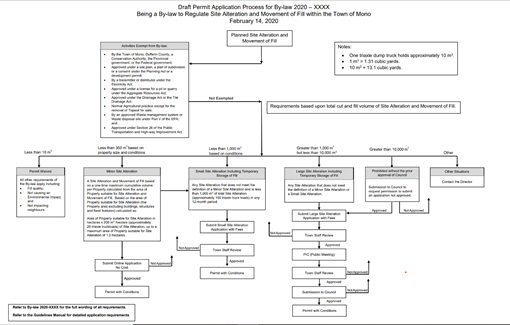Summary of Issue
Things to Consider
Site alteration or fill by-laws establish the parameters for site alteration activities in a municipality and typically include the requirement for a permit to be obtained before beginning most types of site alteration activities. The requirement for permits allows municipalities to have greater control and oversight into the management of excess soil within their jurisdiction and allows for review prior to soil movement.
To facilitate the municipality’s review and control, by-laws generally contain a detailed list of requirements for submission with the permit application. Some municipalities have “pared down” their by-laws by transferring the details into a compendium guideline document. This allows for the use of more accessible , plain language descriptions (avoiding legal-ese) and also facilitates amendments and improvements to the permitting process without undertaking a legislative approval process. The creation of a rationale document also supports accountability and transparency.
Short Form References
This page makes reference to:
the “Excess Soil Regulation” which is the short form for the Ontario Regulation 406/19 On-Site and Excess Soil Management made under the Environmental Protection Act.
the “Rules document” which is the short form the reference document to the regulation entitled Rules for Soil Management and Excess Soil Quality Standards
MECP BMP -which is Ministry of Environment, Conservation and Parks document of Excess Soil – A Guide for Best Management Practices.
Brownfields regulation refers to Ontario Regulation 153/04
Key Takeaways
The Excess Soil Regulation distinguishes between reuse sites governed by a site-specific instrument and those not governed by a site-specific instrument.
Section 3 (2) of the Excess Soil Regulation makes reference to those situations where there are municipal by-laws ( and/or other instruments) that are already managing excess soil.
Where the municipal instrument references quality, then related requirements of the Excess Soil Regulation will defer to it, when excess soil is going to a reuse site.
Where the municipal instrument references quantity, then related requirements of the Excess Soil Regulation will defer to it, when excess soil is going to a reuse site. This includes the case where quantity is not specifically/numerically identified but the beneficial reuse purpose is identified and describes a condition that would become the upper limit on quantity.
Note that the way the Excess Soil Regulation refers to beneficial reuse, it can be tied to how much excess soil is really needed for a given beneficial reuse.
Note that the above only applies when excess soil is received at reuse sites in particular. (See inset below for applicable table from the regulation.) Also see the Overview of the Regulation page for a general overview of reuse requirements from the Excess Soil Regulation, with more details on reuse sites governed by a site-specific instrument, as well as resources on the ministry’s excess soil webpage (Handling excess soil | Ontario.ca).
Key Resource
For further information, see MECP’s Factsheets ( https://www.ontario.ca/page/handling-excess-soil with an overview of relevant regulatory requirements, best management practices, FAQs and key definitions related to:
Source sites
Reuse sites
Soil Quality & Beneficial Reuse
Offsite Soil Management – Temporary Soil Storage and Processing
Stormwater Pond Sediment Management
Qualified Persons and Sampling
Infrastructure Projects
Excerpt from Section 4 of the Excess Soil Regulation
Excess soil, reuse site governed by instrument
4. (1) The conditions set out in this section apply for the purposes of paragraph 4 of subsection 3 (2).
(2) If the reuse site is governed by an instrument in which the quality of excess soil deposited at the reuse site is addressed in the manner described in Column 1 of the following Table, the conditions set out opposite in Column 2 of the Table must be satisfied:
(3) If the reuse site is governed by an instrument in which the quality of excess soil deposited at the reuse site is not addressed, the condition set out in paragraph 1 of subsection 5 (1) must be satisfied.
(4) If the reuse site is governed by an instrument in which the quantity of excess soil deposited at the reuse site is addressed in the manner described in Column 1 of the following Table, the conditions set out opposite in Column 2 of the Table must be satisfied:
(5) If the reuse site is governed by an instrument that does not specify a maximum amount of excess soil that may be deposited at the reuse site and does not identify the beneficial purpose for which the excess soil is to be used, the quantity of excess soil to be deposited at the reuse site must not exceed the quantity necessary for the purposes of the apparent beneficial purpose for which the excess soil is to be used, as determined by examining the circumstances in which the instrument was obtained, the type of undertaking for which the excess soil is to be used and any other relevant circumstance
Municipal Examples
Some municipalities are proposing to amend the permitting process according to site alteration size thresholds. King Township proposes (by-law expected to be adopted in early 2021) three site alteration size thresholds with differing Permit application requirements and fees. They are listed as follows:
“Minor Site Alteration” means a one-time maximum cumulative volume of Site Alteration per Property based on the area of Property suitable for Site Alteration (the Property area excluding buildings, structures and fixed features) calculated according to a defined formula with various restrictions and controls.
“Sma|l Site Alteration” means any Site Alteration that does not meet the definition of a Minor Site Alteration and is less than 1,000 m3 of total Site Alteration (approximately 100 triaxle truckloads) in any 12-month period.
“Large Site Alteration” means any Site Alteration that does not meet the definition of a Minor Site Alteration or a Small Site Alteration.[1]
The Town of Mono also proposes changes to permit requirements according to volume. Small or minor site alterations would not require permits where as large site alterations would require a permit as well as additional assurances such as a Fill Management Plan prepared by a QP, a Public Information Centre and a legal agreement. For Large site alterations greater than 10,0000 m3, the additional requirement of Council approval is required. [2]
See accompanying flowchart below which helps applicants navigate the permit application requirements [3]
Town of Mono, Permit Requirement Flowchart https://mono.civicweb.net/document/56771 This is a temporary site while the approval process is underway. See and search on Town of Mono | Home for permanent location.
Sample Language
4.4 The following activities require a Permit that is obtained by following the specified Permit Application process outlined in the Guidelines Manual:
(a) Minor Site Alteration defined as a one-time maximum cumulative volume of Site Alteration per Property, in a 12-month period, based on the area of Property suitable for Site Alteration (the Property area excluding buildings, structures and fixed features) calculated as follows:
Area of Property suitable for Site Alteration in hectares x 350 m3 /hectare (approximately 35 triaxle truckloads) of Site Alteration, up to a maximum area of Property suitable for Site Alteration of 1.0 hectares.
The maximum volume calculation excludes any Site Alteration conducted under the approval of any other legal instrument of the Town such as a Building Permit or Swimming Pool Permit.
The Minor Site Alteration Permit Application process must be followed.
4.5 Any Site Alteration that does not meet the definition of a Minor Site Alteration and is less than 1,000 m3 of total Site Alteration volume (approximately 100 triaxle truckloads) in any 12-month period is defined as a Small Site Alteration. A Permit is required for a Small Site Alteration. The Small Site Permit Application process must be followed.
4.6 Any Site Alteration that does not meet the definition of a Minor Site Alteration or a Small Site Alteration is considered a Large Site Alteration. A Permit is required for a Large Site Alteration. The Large Site Permit Application process must be followed which includes:
a) A Site Alteration and Fill Management Plan prepared by a Qualified Person; b) A Public Information Centre, or as determined by the Director; c) A legal agreement with the Town at the discretion of the Director; and d) Approval of Council. Any Site Alteration and Movement of Fill in excess of 10,000 m3 (approximately 1,000 triaxle truckloads) is prohibited with out the prior approval of Council to apply for a Permit under the Large Site Permit Application process.
“All applications for site alteration or exemptions will be made to: (a) in the case of rural land, to the Committee;
6 (b) in the case of non rural land, where the volume of fill involved is 5,000 m3 or less, to the Director; and, (c) in the case of non rural land, where the volume of fill involved is more than 5,000 m 3 , to the Committee. [4]”
Municipal Examples
The Town of Whitchurch-Stouffville has developed a Guideline for Application for a Site Alteration and Fill Permit as per By-law 2019 that was prepared to assist Permit applicants understand the requirements of the municipality’s site alteration by-law.
Sample Language
To assist applicants, the public, Council, staff and others in understanding content and requirements of the Township of King’s proposed and draft Site Alteration by-law, a Guidelines Manual (pending) has been created. Although the Guidelines Manual is referenced in the By-law it is not a legal instrument. It can be updated by the Director from time to time as the Director sees fit to assist users of the By-law. The Guidelines Manual provides rationale and guidance for the assistance of users.
Things to Consider
“Volume Creep”
“One of most difficult aspects of municipal management of site alteration and filling is dealing with "volume creep". This is the situation where site alteration and filling start small and continues for a long period of time at a small rate that ultimately results in a cumulative large volume alteration. To address this situation Minor Site Alterations are a one-time volume limited event per property based on property size. This assumes that a one-time event of limited size (based on property size) is unlikely to cause a significant impact. This approach will allow landowners to conduct site alterations and filling activities that are “Minor” in scope, impact and liability without direct engagement with the Township. However, these are one-time events per property in order to prevent Volume Creep. Landowners must apply to the Township for a Permit for all future site alterations regardless of size and indicate on the application the previous Minor Site Alteration. In this fashion the Township can monitor the impacts of volume creep through the Permit process.” [5]
Things to Consider
“Permit Form”
The Permit document should outline the basic details of the application including a list of all supporting documentation such as a Fill Management Plan (if applicable) on the basis of which, the Permit was issued. The Permit should also outline the basic Conditions:
Issue date;
Expiry date; and
Total volume of site alteration and movement of fill.
References
[1] Town of Mono - By-law 2020-XXXX, a By-law to Regulate Site Alteration and Movement of Fill within the Town of Mono. Town of Mono | Home
[2] Town of Mono, Permit Requirement Flowchart https://mono.civicweb.net/document/56771 This is a temporary site while the approval process is underway. See and search on Town of Mono | Home for permanent location.
[3] King Township – By-law 2020-xxxx Note – as this by-law has not yet been adopted, the staff report link is located on the Town’s engagement site at: Site Alteration By-law Review | SPEAKING - Your voice, our community.
[4] Halton Hills Site Alteration and Fill By-law 2017 Site Alterations - Halton Hills
[5] King Township – Rationale Document / Staff Report December 2020 Site Alteration By-law Review | SPEAKING - Your voice, our community






